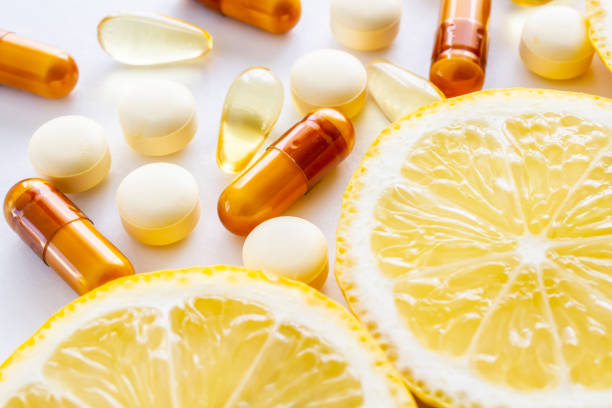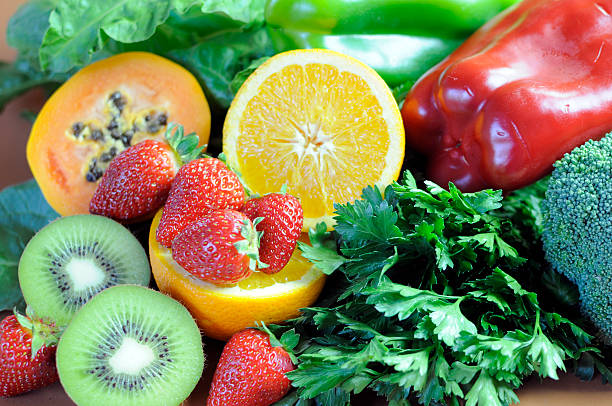Recommended Intakes
Intake recommendations for vitamin C and other nutrients are provided in the Dietary Reference Intakes (DRIs) developed by the Food and Nutrition Board (FNB) at the Institute of Medicine (IOM) of the National Academies (formerly National Academy of Sciences). DRI is the general term for a set of reference values used for planning and assessing nutrient intakes of healthy people. These values, which vary by age and gender, include:
● Recommended Dietary Allowance (RDA): Average daily level of intake sufficient to meet the nutrient requirements of nearly all (97%–98%) healthy individuals; often used to plan nutritionally adequate diets for individuals.
● Adequate Intake (AI): Intake at this level is assumed to ensure nutritional adequacy; established when evidence is insufficient to develop an RDA.
● Estimated Average Requirement (EAR): Average daily level of intake estimated to meet the requirements of 50% of healthy individuals; usually used to assess the nutrient intakes of groups of people and to plan nutritionally adequate diets for them; can also be used to assess the nutrient intakes of individuals.
● Tolerable Upper Intake Level (UL): Maximum daily intake unlikely to cause adverse health effects.
Table 1 lists the current RDAs for vitamin C. The RDAs for vitamin C are based on its known physiological and antioxidant functions in white blood cells and are much higher than the amount required for protection from deficiency. For infants from birth to 12 months, the FNB established an AI for vitamin C that is equivalent to the mean intake of vitamin C in healthy, breastfed infants.
Table 1: Recommended Dietary Allowances (RDAs) for Vitamin C
Age Male Female Pregnancy Lactation
0–6 months 40 mg* 40 mg*
7–12 months 50 mg* 50 mg*
1–3 years 15 mg 15 mg
4–8 years 25 mg 25 mg
9–13 years 45 mg 45 mg
14–18 years 75 mg 65 mg 80 mg 115 mg
19+ years 90 mg 75 mg 85 mg 120 mg
Smokers Individuals who smoke require 35 mg/day
more vitamin C than nonsmokers.
* Adequate Intake (AI)
Sources of Vitamin C
Food
Fruits and vegetables are the best sources of vitamin C (see Table 2). Citrus fruits, tomatoes and tomato juice, and potatoes are major contributors of vitamin C to the American diet. Other good food sources include red and green peppers, kiwifruit, broccoli, strawberries, Brussels sprouts, and cantaloupe (see Table 2). Although vitamin C is not naturally present in grains, it is added to some fortified breakfast cereals. The vitamin C content of food may be reduced by prolonged storage and by cooking because ascorbic acid is water soluble and is destroyed by heat. Steaming or microwaving may lessen cooking losses. Fortunately, many of the best food sources of vitamin C, such as fruits and vegetables, are usually consumed raw. Consuming five varied servings of fruits and vegetables a day can provide more than 200 mg of vitamin C.
Table 2: Selected Food Sources of Vitamin C
Food
Milligrams (mg) per serving
Percent (%) DV*
Red pepper, sweet, raw, ½ cup 95 158
Orange juice, ¾ cup 93 155 Orange, 1 medium 70 117 Grapefruit juice, ¾ cup 70 117 Kiwifruit, 1 medium 64 107
Green pepper, sweet, raw, ½ cup 60 100
Broccoli, cooked, ½ cup 51 85
Strawberries, fresh, sliced, ½ cup 49 82
Brussels sprouts, cooked, ½ cup 48 80
Grapefruit, ½ medium 39 65 Broccoli, raw, ½ cup 39 65 Tomato juice, ¾ cup 33 55
Cantaloupe, ½ cup 29 48 Cabbage, cooked, ½ cup 28 47
Cauliflower, raw, ½ cup 26 43 Potato, baked, 1 medium 17 28
Tomato, raw, 1 medium 17 28
Spinach, cooked, ½ cup 9 15
Green peas, frozen, cooked, ½ cup 8 13
*DV = Daily Value. The U.S. Food and Drug Administration (FDA) developed DVs to help consumers compare the nutrient contents of products within the context of a total diet. The DV for vitamin C used for the values in Table 2 is 60 mg for adults and children age 4 years and older. This DV, however, is changing to 90 mg as the updated Nutrition and Supplement Facts labels are implemented. The updated labels and DVs must appear on food products and dietary supplements beginning in January 2020, but they can be used now. FDA requires current food labels to list vitamin C content, but this requirement will be dropped with the updated labels. Foods providing 20% or more of the DV are considered to be high sources of a nutrient, but foods providing lower percentages of the DV also contribute to a healthful diet.
Dietary supplements
Supplements typically contain vitamin C in the form of ascorbic acid, which has equivalent bioavailability to that of naturally occurring ascorbic acid in foods, such as orange juice and broccoli. Other forms of vitamin C supplements include sodium ascorbate; calcium ascorbate; other mineral ascorbates; ascorbic acid with bioflavonoids; and combination products, such as Ester-C®, which contains calcium ascorbate, dehydroascorbate, calcium threonate, xylonate and lyxonate.
A few studies in humans have examined whether bioavailability differs among the various forms of vitamin C. In one study, Ester-C® and ascorbic acid produced the same vitamin C plasma concentrations, but Ester-C® produced significantly higher vitamin C concentrations in leukocytes 24 hours after ingestion. Another study found no differences in plasma vitamin C levels or urinary excretion of vitamin C among three different vitamin C sources: ascorbic acid, Ester-C®, and ascorbic acid with bioflavonoids. These findings, coupled with the relatively low cost of ascorbic acid, led the authors to conclude that simple ascorbic acid is the preferred source of supplemental vitamin C.



